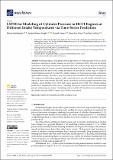| dc.contributor.author | Sontheimer, Moritz | |
| dc.contributor.author | Singh, Anshul-Kumar | |
| dc.contributor.author | Verma, Prateek | |
| dc.contributor.author | Chou, Shuo-Yan | |
| dc.contributor.author | Kuo, Yu-Lin | |
| dc.date.accessioned | 2023-10-27T18:27:07Z | |
| dc.date.available | 2023-10-27T18:27:07Z | |
| dc.date.issued | 2023-09-25 | |
| dc.identifier.uri | https://hdl.handle.net/1721.1/152529 | |
| dc.description.abstract | Modeling engines using physics-based approaches is a traditional and widely-accepted method for predicting in-cylinder pressure and the start of combustion (SOC). However, developing such intricate models typically demands significant effort, time, and knowledge about the underlying physical processes. In contrast, machine learning techniques have demonstrated their potential for building models that are not only rapidly developed but also efficient. In this study, we employ a machine learning approach to predict the cylinder pressure of a homogeneous charge compression ignition (HCCI) engine. We utilize a long short-term memory (LSTM) based machine learning model and compare its performance against a fully connected neural network model, which has been employed in previous research. The LSTM model’s results are evaluated against experimental data, yielding a mean absolute error of 0.37 and a mean squared error of 0.20. The cylinder pressure prediction is presented as a time series, expanding upon prior work that focused on predicting pressure at discrete points in time. Our findings indicate that the LSTM method can accurately predict the cylinder pressure of HCCI engines up to 256 time steps ahead. | en_US |
| dc.publisher | Multidisciplinary Digital Publishing Institute | en_US |
| dc.relation.isversionof | http://dx.doi.org/10.3390/machines11100924 | en_US |
| dc.rights | Creative Commons Attribution | en_US |
| dc.rights.uri | https://creativecommons.org/licenses/by/4.0/ | en_US |
| dc.source | Multidisciplinary Digital Publishing Institute | en_US |
| dc.title | LSTM for Modeling of Cylinder Pressure in HCCI Engines at Different Intake Temperatures via Time-Series Prediction | en_US |
| dc.type | Article | en_US |
| dc.identifier.citation | Machines 11 (10): 924 (2023) | en_US |
| dc.contributor.department | Program in Media Arts and Sciences (Massachusetts Institute of Technology) | |
| dc.identifier.mitlicense | PUBLISHER_CC | |
| dc.eprint.version | Final published version | en_US |
| dc.type.uri | http://purl.org/eprint/type/JournalArticle | en_US |
| eprint.status | http://purl.org/eprint/status/PeerReviewed | en_US |
| dc.date.updated | 2023-10-27T10:26:46Z | |
| dspace.date.submission | 2023-10-27T10:26:46Z | |
| mit.license | PUBLISHER_CC | |
| mit.metadata.status | Authority Work and Publication Information Needed | en_US |
